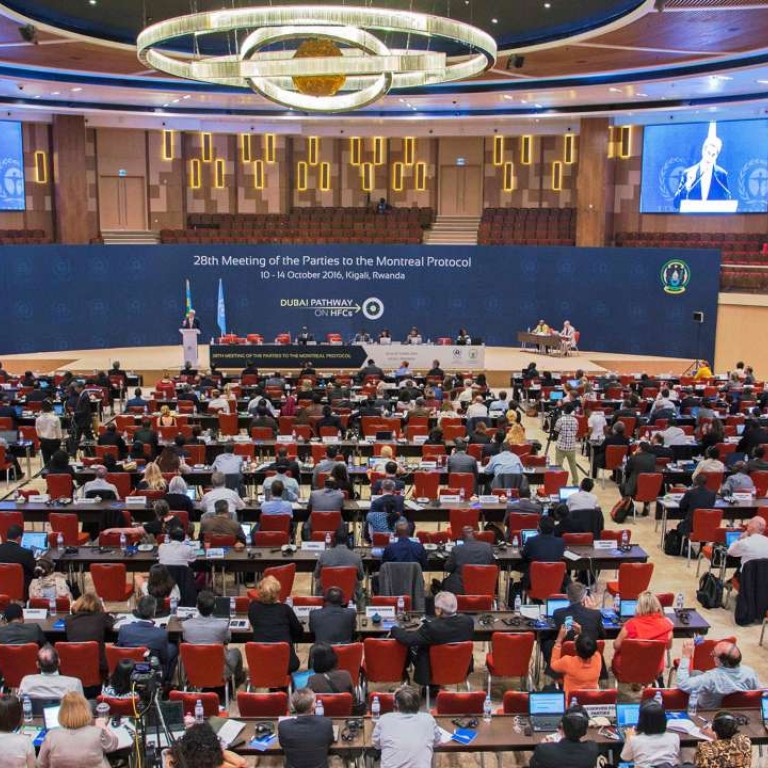
150 nations reach deal to limit powerful greenhouse gases
The talks on hydrofluorocarbons (HFCs) have been called the first test of global will since the historic Paris Agreement to cut carbon emissions was reached last year
Nations have reached a deal to limit the use of greenhouse gases far more powerful than carbon dioxide in a major effort to fight climate change.
The talks on hydrofluorocarbons, or HFCs, have been called the first test of global will since the historic Paris Agreement to cut carbon emissions was reached last year. HFCs are described as the world’s fastest-growing climate pollutant and are used in air conditioners and refrigerators.
The agreement announced on Saturday morning, after all-night negotiations, caps and reduces the use of HFCs in a gradual process beginning in 2019 with action by developed countries including the United States, the world’s second worst polluter. More than 100 developing countries, including China, the world’s top carbon emitter, will start taking action in 2024.
A small group of countries including India, Pakistan and some Gulf states pushed for and secured a later start in 2029, saying their economies need more time to grow. That’s two years earlier than India, the world’s third worst polluter, had first proposed.
Compromises had to be made, but 85 per cent of developing countries have committed to the early schedule starting 2024, which is a very significant achievement
Environmental groups had hoped that the deal could reduce global warming by a half-degree Celsius by the end of this century. This agreement gets about 90 per cent of the way there, said Durwood Zaelke, president of the Institute for Governance and Sustainable Development.
Zaelke’s group said this is the “largest temperature reduction ever achieved by a single agreement”.
The new agreement is “equal to stopping the entire world’s fossil-fuel CO2 emissions for more than two years”, David Doniger, climate and clean air programme director with the Natural Resources Defense Council, said in a statement.
Experts said they hope that market forces will help speed up the limits agreed to in the deal.
“Compromises had to be made, but 85 per cent of developing countries have committed to the early schedule starting 2024, which is a very significant achievement,” Clare Perry, UK Climate Campaign Leader with the Environmental Investigation Agency, said in a statement.

HFCs were introduced in the 1980s as a substitute for ozone-depleting gases. But their danger has grown as air conditioner and refrigerator sales have soared in emerging economies like China and India. HFCs are also found in inhalers and insulating foams.
Major economies have debated how fast to phase out HFCs. The United States, whose delegation was led by Secretary of State John Kerry, and Western countries want quick action. Nations such as India want to give their industries more time to adjust.
Small island states and many African countries had pushed for quick action, saying they face the biggest threat from climate change.
“It may not be entirely what the islands wanted, but it is a good deal,” the minister-in-assistance to the president of the Marshall Islands, Mattlan Zackhras, said in a statement. “We all know we must go further, and we will go further.”
HFCs are less plentiful than carbon dioxide, but Kerry said last month that they currently emit as much pollution as 300 coal-fired power plants each year. That amount will rise significantly over the coming decades as air conditioning units and refrigerators reach hundreds of millions of new people.
HFCs don’t harm the ozone layer like chlorofluorocarbons and similar gases that were eliminated under the 1987 Montreal Protocol. The entire world ratified that agreement, helping to repair holes in the ozone that helps shield the planet from the harmful rays of the sun. The aim of this meeting was to attach an amendment to that treaty dealing specifically with HFCs.

